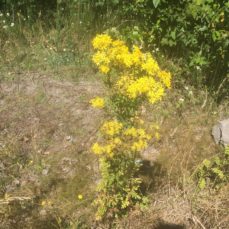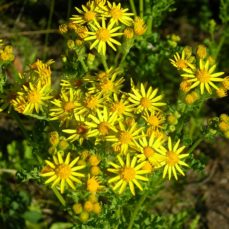
Photo credit: Michael Rasy, University of Alaska, Bugwood.org
Management Category
Squamish
Whistler
Pemberton
Vectors of Spread
ID Characteristics
Tansy ragwort is a biennial or short-lived perennial that can be found throughout Southern British Columbia.
Flowers: Bright yellow, daisy-like flower heads arranged in dense, flat-topped clusters near the top of the stem. Each flower has 10 – 15 ray-like petals surrounding a yellow-orange disk.
Stems: Mature plants range are 0.2 – 1.2 m tall with one or several upright stems that are branched near the top.
Leaves: During the plant’s first year of growth, it produce a low rosette with dark green, ruffled (lobed) leaves on purplish stems. Second-year flowering stems have alternate leaves that are dark green on top and whitish-green underneath, with deeply cut, blunt-toothed lobes and a ragged, ruffled appearance. Basal leaves are stalked, 4 – 20 cm long, and 2 – 6 cm wide.
Seeds: Ribbed seeds are 1 mm long with a cluster of white hairs (called a pappus), about 3 mm long.
Roots: Tansy ragwort has a fibrous system of coarse, light-coloured roots that can produce small, adventitious shoots.
Similar Species
Invasive

Common tansy (Tanacetum vulgare): Perennial species that reproduces by seed and can grow up to 1.8 m in height. Common tansy has many yellow, disc-shaped flowers that are found at the top of the plant in flat-topped clusters.
Common tansy prefers to grow in sunny areas with well-drained soils and cannot establish in frequently tilled soils.

St. John’s wort (Hypericum perforatum): Perennial that grows to about 1 m in height. St. John’s wort has showy, bright yellow flowers with 5 petals that turn rusty red when they mature. It prefers dry, sandy soils and grows in full sun.
Habitat and Origin
Native to Europe, Tansy Ragwort was first seen in North America in the 1900’s. It was most likely spread in contaminated hay.
Tansy ragwort thrives in full sun or partial shade with well-drained soil, and is not commonly found in areas with high water tables or acidic soil. It invades disturbed sites and bare ground in grazed pastures, roadsides, vacant non-crop lands and forest clear-cuts.
How it Spreads
Tansy ragwort reproduces mainly by seeds, which can remain viable for up to 15 years depending on depth in the soil. Tilling, grazing or other disturbances will cause dormant seeds to germinate. Plants that go to seed will die at the end of the season.
Regeneration of shoots can also occur from crown buds, root fragments and intact roots. As with the seeds, disturbance or injury to shoots promotes vegetative propagation.
Tansy ragwort primarily spreads by its seeds, which get carried off in the wind. While most seeds are dispersed within 10 m of the original plant, some may be spread by people, water, animals, and livestock. Seeds are also transported in soil being carried by equipment or vehicles.
Impacts
Ecological:
- Contains alkaloids that are toxic to cattle, deer, pigs, horses and goats.
- In susceptible animals, liver damage resulting from tansy ragwort ingestion is cumulative.
Economic:
- Can reduce overall productivity and stocking levels in areas utilized by livestock.
- The alkaloids in tansy ragwort taint honey, such that it is usually too bitter and off-color to market.
Prevent the Spread
Tansy ragwort is found in the Sea to Sky region, but with a limited distribution. The goal is to eradicate this species from the region, and to prevent new introductions.
Learn to identify tansy ragwort: use the images on this page to learn how to identify tansy ragwort.
What to do if you spot it: You can report any tansy ragwort sighting by visiting our reporting page..
DO:
- Regularly monitor properties for weed infestations.
- Ensure soil and gravel is uncontaminated before transport
- Quickly re-vegetate disturbed areas with fast-growing competitive, native plants can limit growth of tansy ragwort and is a fundamental tool to limit it.
- Minimize soil disturbance in area surrounding infestation
- Ensure plants (particularly flowering heads or root fragments) are bagged or covered to prevent spread during transport to designated disposal sites (e.g. landfill).
DO NOT:
- Plant tansy ragwort in a garden, no matter how well-contained its enclosure may seem.
- Move soil that has been contaminated with tansy ragwort.
- Unload, park, or store equipment or vehicles in infested areas; remove plant material from any equipment, vehicles, or clothing used in such areas and wash equipment and vehicles at designated cleaning sites before leaving infested areas.
Control
Mechanical Control
Only effective on established stems if the root system is entirely removed or frequently cultivated (tilled), which prevents the growth of seedlings and root sprouts. Repeated heavy cultivation can be used as a control technique and frequent mowing before flowering can prevent seed production. Hand pulling is only effective in small infestations and if root is completely removed.
Chemical Control
- The use of a wick or selective spot spraying is recommended to minimize non-target damage.
- Effective herbicides include dicamba, 2,4-D, picloram, and picloram + 2,4-D. Spring or mid-summer applications of 2,4-D are most effective at managing young seedlings and rosettes, while dicamba/dicamba + 2,4-D are more effective on advanced growth stages.
- Note that picloram is not suitable for wet coastal soils.
We recommend that any herbicide application is carried out by a person holding a valid BC Pesticide Applicator Certificate. Before selecting and applying herbicides, you must review and follow herbicide labels and application rates; municipal, regional, provincial and federal laws and regulations; species-specific treatment recommendations, and site-specific goals and objectives.
Biocontrol
Defoliating moths (Tyriah jacobaeae), root feeding beetles (Longitarsis flavicorni, L. jacobaeae), and seed head flies (Hylemya seneciella) have been effective in biologically controlling tansy ragwort in places such as the Fraser Valley.
Sea to Sky Distribution
Tansy Ragwort Factsheet
Having trouble viewing the factsheet? Don’t worry, all the information is included on this page. You can also contact us with any questions.
Additional Resources
References
- Coastal Invasive Species Committee, Tansy Ragwort
- Fraser Valley Invasive Species Society, Tansy Ragwort
- Government of BC, “Tansy Ragwort”, in Field Guide to Noxious Weeds and Other Selected Invasive Plants of British Columbia
- Invasive Species Council of British Columbia, Tansy Ragwort
- Invasive Species Council of British Columbia, Tansy Ragwort TIPS Factsheet
- Invasive Species Council of Metro Vancouver, Tansy Ragwort
- King County Noxious Weeds Control Board, Tansy Ragwort Identification and Control











